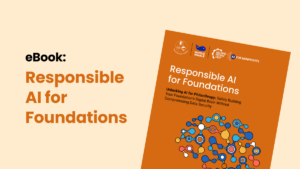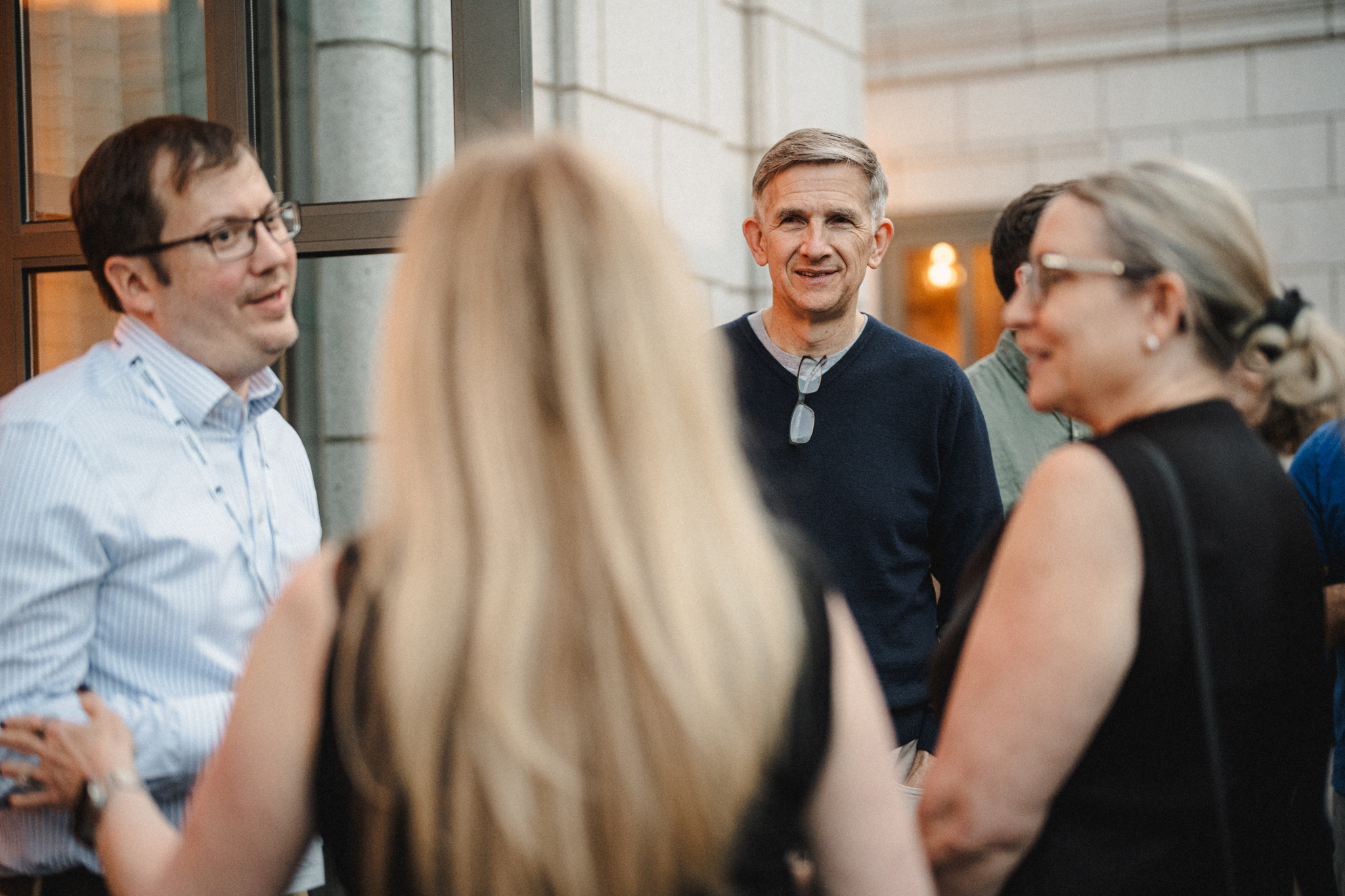The artificial intelligence revolution has arrived in philanthropy, and foundation leaders can no longer afford to sit on the sidelines. With 81% of foundations reporting some degree of AI usage and nearly 30% of employed US adults using ChatGPT at work, the question isn’t whether AI will transform grantmaking—it’s how quickly foundations can harness these tools to amplify their mission impact.
The AI Landscape: What’s Changed and What’s Coming
Rapid Adoption and Integration
AI has escaped the chatbot paradigm. Today’s foundation professionals are interacting with AI whether they realize it or not—through Google search, Microsoft Office products, and countless other integrated tools. OpenAI reports that 500 million individuals globally use ChatGPT, with over 300 million messages processed daily in the US alone. More significantly, 280 million companies worldwide have integrated AI into their operations.
This represents the fastest adoption of any consumer technology in history, surpassing even the iPhone and internet in penetration speed. For foundations, this means the technology landscape around you is shifting rapidly, and staying current requires intentional engagement rather than passive observation.
As AI technology evolves, companies are seeking ways to integrate it into grants, foundation, and scholarship
management solutions. These workspaces tend to be purpose-built to support your specific use cases and are
secure (i.e., not open AI) – removing your risk of data being used by an AI engine outside of one’s owned
environment.– George Weiner, The Whole Wale
The Evolution to AI Agents
The next generation of AI tools goes far beyond simple question-and-answer interactions. Modern AI agents combine large language models with three critical capabilities:
- Internet access for real-time information gathering
- Application integration to access calculators, databases, and specialized tools
- Extended memory to maintain context across longer, more complex tasks
This evolution enables AI to work for extended periods—up to an hour of continuous operation—opening possibilities for comprehensive research, analysis, and report generation that were impossible just two years ago.
Decreasing Costs, Increasing Accessibility
Perhaps most importantly for budget-conscious foundations, AI costs are plummeting. Improvements in hardware, software algorithms, and market competition have made AI tools increasingly affordable. The barrier to piloting AI solutions has dropped dramatically, making experimentation accessible even for smaller foundations.
Also, know that if you aren’t paying for the product, your data is the product – pay close attention to privacy policies for these tools.
– George Weiner, The Whole Wale
Practical Applications: AI Tools for Foundation Excellence
Strategic Opportunity Identification
Smart foundations are moving beyond basic AI experimentation to systematic implementation. The key is training AI tools before using them, just as you would orient a new staff member.
Start by feeding the AI examples of organizations you fund, your program strategies, and assessment criteria. Then leverage the expanded “context window”—modern AI can process entire book-length documents—to analyze comprehensive information sets.
For opportunity identification, try these approaches:
- Upload examples of successful grantees and ask for similar organizations
- Provide your strategic priorities and request analysis of emerging trends
- Input multiple funding areas and ask what you might be missing
Streamlined Grant Review and Due Diligence
AI excels at processing large volumes of information quickly and consistently. Foundation leaders are using AI to:
Proposal Assessment: Upload your evaluation criteria alongside multiple proposals. Ask the AI to assess each proposal against your framework, providing scored summaries and comparative analysis. Remember to iterate—the first output likely won’t match your approach perfectly.
Expert Identification: For complex proposals requiring external review, AI can identify relevant experts, provide rationales for their relevance, and even draft initial outreach emails. This dramatically reduces the time spent building reviewer networks.
Risk Assessment: Process large applicant lists by asking AI to flag potential reputational concerns or negative coverage. While not definitive, this provides an efficient first-pass screening.
Progress Monitoring: Upload multiple progress reports and ask AI to flag concerning patterns, limited progress, or other issues requiring closer attention.
Language Accessibility: AI translation capabilities eliminate language barriers, enabling foundations to engage with proposals and communications in any language.
Evaluating AI-Inclusive Grant Proposals
As AI becomes more prevalent, foundations increasingly encounter funding requests that incorporate AI components. Your existing evaluation criteria remain relevant—focus on team quality, organizational capacity, budget reasonableness, and track record.
However, add these AI-specific considerations:
Technical Sustainability: Who will maintain and improve the AI tool after initial development? Avoid the “undergraduate bump”—brilliant student developers who will leave after building the initial prototype.
Scale Economics: AI tools typically charge per use, meaning success costs more. Ensure budgets account for increased usage as tools prove effective.
Data Pipeline Clarity: Understand where training data originates, how it flows through the system, and where it goes afterward. This is crucial for both effectiveness and privacy.
Human Integration: Look for clear “human in the loop” components. AI tools work best when augmenting rather than replacing human judgment and oversight.
Addressing Privacy and Ethical Concerns
Data privacy represents a critical consideration for foundations handling sensitive information. Consumer versions of AI tools may use uploaded data for training future models, but enterprise versions typically include privacy protections and compliance features.
Key privacy strategies include:
- Using enterprise-grade AI tools with data protection toggles
- Developing organizational AI policies before widespread adoption
- Considering custom AI models that create private “sandboxes” for sensitive work
- Training custom models on your foundation’s mission, values, and priorities
Ethical considerations extend beyond privacy to include:
- Environmental impact of AI companies and their energy usage
- Transparency with grantees and beneficiaries about AI usage
- Reliability and bias in AI-generated recommendations
- Impact on downstream communities served by your grantees
Building AI Capacity: Buy vs. Build Decisions
Most foundations face a fundamental choice: purchase existing AI-enabled tools or develop custom solutions. The answer depends on your technical capacity, budget, and specific needs.
Buying AI Tools offers advantages including:
- Regular updates and improvements from dedicated development teams
- Shared costs across multiple customers
- Immediate implementation without technical hiring
Building Custom Solutions provides:
- Complete customization for your specific workflows
- Full data control and privacy
- Integration with existing systems and processes
The talent market for AI developers has improved significantly over the past year, though skilled professionals remain expensive. Many foundations are finding success with hybrid approaches—purchasing foundational tools while developing specific customizations.
Getting Started: A Practical Framework
Phase 1: Foundation Building
- Develop organizational AI policies addressing privacy, ethics, and acceptable use
- Identify pilot use cases with clear success metrics
- Train key staff on prompt engineering and AI interaction best practices
Phase 2: Strategic Implementation
- Choose 2-3 specific workflows for AI integration (e.g., proposal review, expert identification)
- Implement enterprise-grade tools with appropriate privacy protections
- Establish feedback loops for continuous improvement
Phase 3: Scaling Impact
- Expand successful pilots to additional program areas
- Consider custom AI development for unique organizational needs
- Share learnings with peer foundations and grantees
The Future of AI in Philanthropy
Leading foundations are already demonstrating AI’s transformative potential. Organizations like Future House have developed AI agent systems that automate entire scientific workflows, from literature review through hypothesis generation to experimental design. While few foundations need such sophisticated systems, these examples illustrate AI’s potential as a force multiplier.
The technology will continue evolving rapidly. Web browsers, email clients, and office tools designed around AI rather than retrofitted with AI capabilities are emerging. Foundations that begin experimenting now will be better positioned to leverage these advances.
Moving Forward with Confidence
The AI revolution in philanthropy isn’t coming—it’s here. The question for foundation leaders isn’t whether to engage with AI, but how quickly you can do so responsibly and effectively.
Start small, prioritize privacy and ethics, and remember that AI works best when augmenting rather than replacing human judgment. Focus on problems you want to solve rather than tools you want to use. Most importantly, maintain the human relationships and values that make philanthropy meaningful while leveraging AI to amplify your impact.
The foundations that thoughtfully integrate AI into their operations today will be the ones multiplying their mission impact tomorrow. The technology is ready, the costs are manageable, and the potential for good is enormous. The only question is: what will you build?
Watch the recording of Foundant’s webinar featuring Michael Belinsky and Darian Rodriguez Heyman to learn more about this topic.
Contributor Bios:
About the Author

Darian Rodriguez Heyman is the author of the bestselling book, AI for Nonprofits (Wiley, 2025), featuring insights from 57 sector leaders and actionable strategies for using AI to advance fundraising, marketing, program delivery, and operations. He is a philanthropic consultant who helps foundations of all sizes responsibly embrace AI for internal operations and to build grantee capacity. As founder of AI4NP.org—a fiscally sponsored initiative by NTEN—he’s building a digital Learning Hub for AI for good resources and launching a national Learning Lab series to build sector capacity around responsible AI adoption.
A nonprofit strategist, philanthropic advisor, and keynote speaker with 20+ years of tactical experience, Darian has supported transformational initiatives across the sector. He launched Craigslist Foundation’s acclaimed Nonprofit Boot Camp as their ED, helped the UN develop the SDGs around climate and gender, co-founded 2XGlobal to funnel billions to women-led businesses, and helped direct over $200M to Black-led nonprofits. As a thought leader, he has keynoted globally and authored the bestselling Nonprofit Management 101 and Nonprofit Fundraising 101, establishing himself as a trusted voice for mission-driven leaders worldwide. Through his consultancy Helping People Help, Darian provides executive coaching and consulting specializing in AI implementation, fundraising, board development, and strategic planning for mission-led organizations.
About the Author

Michael Belinsky is an expert in nonprofit strategy, fundraising, and grant development, with a track record of helping organizations secure transformative funding. Michael is an accomplished leader and social entrepreneur with more than 15 years of experience making investments and leading teams focused on topics spanning AI, philanthropy, impact investing, and global development. Currently, he is a Director in the AI and Advanced Computing Institute at Schmidt Sciences, a philanthropy co-founded by Eric and Wendy Schmidt to foster the advancement of science and technology. His work there builds on his previous roles as Director at Schmidt Futures, Principal at the Bridgespan Group, and Co-Founder of the social enterprise, Instiglio. His work has been instrumental in helping mission-driven organizations secure resources for groundbreaking initiatives, including technology and AI upgrades. https://www.linkedin.com/in/michaelbelinsky/

